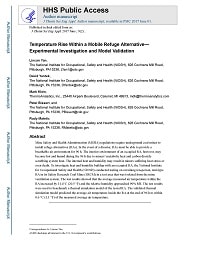Mining Publication: Temperature Rise Within a Mobile Refuge Alternative (RA) - Experimental Investigation and Model Validation
Original creation date: June 2017
Authors: L Yan, DS Yantek, M Klein, P Bissert, RJ Matetic
Mine Safety and Health Administration (MSHA) regulations require underground coal mines to install refuge alternatives (RAs). In the event of a disaster, RAs must be able to provide a breathable air environment for 96 hours. The interior environment of an occupied RA, however, may become hot and humid during the 96 hours due to miners' metabolic heat and carbon dioxide scrubbing system heat. The internal heat and humidity may result in miners suffering heat stress or even death. To investigate heat and humidity buildup with an occupied RA, the National Institute for Occupational Safety and Health (NIOSH) conducted testing on a training 10-person, tent-type RA in its Safety Research Coal Mine (SRCM) in a test area that was isolated from the mine ventilation system. The test results showed that the average measured air temperature within the RA increased by 11.4 degrees C (20.5 degrees F) and the relative humidity approached 90% RH. The test results were used to benchmark a thermal simulation model of the tested RA. The validated thermal simulation model predicted the average air temperature inside the RA at the end of 96 hours to within 0.6 degrees C (1.1 degrees F) of the measured average air temperature.

- Analysis of Heat Loss Mechanisms for Mobile Tent-Type Refuge Alternatives
- Announcing Two New Sister Publications on Refuge Alternatives
- Effects of Mine Strata Thermal Behavior and Mine Initial Temperatures on Mobile Refuge Alternative Temperature
- Estimation of Metabolic Heat Input for Refuge Alternative Thermal Testing and Simulation
- Evaluation of the Relative Importance of Coalbed Reservoir Parameters for Prediction of Methane Inflow Rates During Mining of Longwall Development Entries
- Investigation of Temperature Rise in Mobile Refuge Alternatives
- Portable Refuge Alternatives Temperature and Humidity Tests
- Prediction of Human Core Temperature Rise and Moisture Loss in Refuge Alternatives for Underground Coal Mines
- Refuge Alternatives in Underground Coal Mines
- Technology News 537 - NIOSH Develops New Mine Refuge Chamber Training